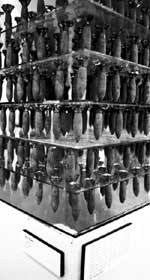|
Duct tape as art of war
 |
Heather Morrison/Chronicle
Jno Cooks Four Rivers installation is part of Terrorist Art: Protesting War, on display at the Polvo Art Studio, 1257 W. 18th St., through April 19. |
|
By Michael Hirtzer
A&E Editor
Duct tape, the all-purpose
silver tape, is finding its way into a surprising
amount of art as of late. In response to the government
touting the tubular tape as a precautionary measure
against biological weapons, artists have incorporated
it and other unusual items into their work.
The heightened state of awareness toward war and
terrorism, both home and abroad, has no doubt
inspired the work; after all, war probably ranks
second only to love as a source of artistic muse.
At the Polvo Art Studio, a small gallery in Pilsen
at 1257 W. 18th St., an exhibit entitled “Terrorist
Art: Protesting War,” which runs through
Saturday, April 19, displays a variety of works,
all adverse to the war with Iraq.
Some of the works are comical, like Juan Compean’s
“Terrorist, Death and Freedumb Fries,”
a chalk-and-charcoal drawing over a screenprint
on brown craft paper with three degenerative portraits
of President George W. Bush. The first shows a
funny-faced Bush saying: “Hey! Who sprinkled
anthrax on my freedumb fries?”
The second has Bush wearing a suit and a cowboy
hat saying: “Yee-haw! I’m gonna git
me a terrorist.” And the final drawing has
Bush dressed as the grim reaper, scythe and all,
saying: “I am the angel of death.”
Miguel Cortez’s “Homeland Security
Trifold Wallet,” is an actual brown leather
wallet offering free duct tape inside. Cortez,
a former student of the School of the Art Institute
of Chicago and a Columbia film student who designs
packaging and belt wallet presentations for the
Chicago-based Humphreys Accessories, said, “I’m
just trying to be absurd about protecting my money
from terrorists.”
Columbia photography instructor Jno (pronounced
like Jon) Cook’s “Four Rivers”
is a holdover from the early 1990s. It was made
in response to the Persian Gulf War. Referring
to the four rivers in the book of Genesis, signifying
the location of Eden, Cook wrote in his artist
statement: “We are about to bomb Eden back
to a Paleolithic Age.”
 |
Michael Hirtzer/Chronicle
Homeland Insecurity Variety Show participants show what not to do with duct tape. |
|
Other works in the exhibit include a digital collage
titled “Pax Americana” by Tomas Siebley
depicting a human skull with old pocket watches
as eyes and a large bomb as a body and Jesus Macarena-Avila’s
work, which is simply the word “Protect”
spelled out on the gallery wall in duct tape.
“The Homeland Insecurity Variety Show,”
one of the many events included as part of Version
3, a multimedia festival held at several venues
throughout Chicago at the end of March, aimed
at exploring “current performance platforms
and the theme of reclaiming intellectual property
rights and appropriation.”
The variety show included performances by the
Evolution Control Committee, which was basically
a gray-haired man dressed in a white lab coat
mixing breakbeats with samples of the rock band
AC/DC and the voice of CBS news anchor Dan Rather
saying words like murder and disease.
The show also included a session on how to avoid
terror. Utilizing retro iconography, the session
informed audience members about the proper steps
to take during a biological attack or nuclear
winter.
Likewise, the new
government website, www. ready.gov, utilizes iconography
inspired by airline safety procedure cards. The
website, launched in February, coincidentally
corresponds with the publishing of the book, Design
for Impact: 50 Years of Airline Safety Cards.
The mission of the website—part of the Tom
Ridge-headed U.S. Department of Homeland Security—is
to prepare for disasters; “For Americans,
preparedness must now account for man-made disasters
as well as natural ones,” the website states.
“Knowing what to do during an emergency
is an important part of being prepared and may
make all the difference when seconds count.”
And while the website, created by a division of
the New York public relations firm Ruder Finn
Inc., more often than not states the glaringly
obvious (one informs people not to walk into burning
buildings), the low-tech graphics are visually
appealing.
Perhaps war-inspired art—for all its worth—is
best summed-up by an exhibit at the Museum
of Contemporary Art. Running through May 18, the
exhibit is named after the soul singer Edwin Starr’s
song “War.” The song’s refrain
repeats: “War, what is it good for? Absolutely
nothing.”
|